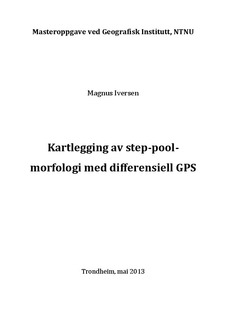Kartlegging av step-pool-morfologi med differensiell GPS
Master thesis
Permanent lenke
http://hdl.handle.net/11250/265563Utgivelsesdato
2013Metadata
Vis full innførselSamlinger
- Institutt for geografi [1120]
Sammendrag
Selected reaches of a step-pool-river in Oppdal, Norway were surveyed using differential GPS. Step-pools is a morphology characteristic of upland rivers with high gradient and large supply of coarse sediments, where channel units are restructured by floods of high magnitude. Differential GPS produces real-time corrected, highly accurate satellite-based positioning and height measurements.
The goal of the study was to measure changes in morphologic variables from the spring flood period between 2011 and 2012, and also to determine if differential GPS produces valid, comparable results without subjective bias.
The analysed field data proved inconclusive. For many reaches, the chosen measuring points from the two years were as much as 5 meters apart, while others overlapped well. In some cases, individual steps could be identified in data from both years, while other reaches showed little similarity. Statistical analysis of variables like step wavelength, height etc. showed relatively large deviations in the measured data.
Researcher subjectivity must be seen as a large source of these deviations. Field classification of study units leaves different operators with the possibility of choosing different measuring points. In some cases, actual channel change could be verified with pictures, but lack of further verification in the form of discharge data makes it difficult to establish what is actual change and what is subjectivity.
Some key improvements are listed for future studies: Train extensively in the use of D-GPS equipment before field work, document the field work with as many pictures as possible, and discuss the selection of measuring points during the actual field work. D-GPS, with the right preparations, has the potential of becoming a useful tool for fluvial-geomorphological field work.
